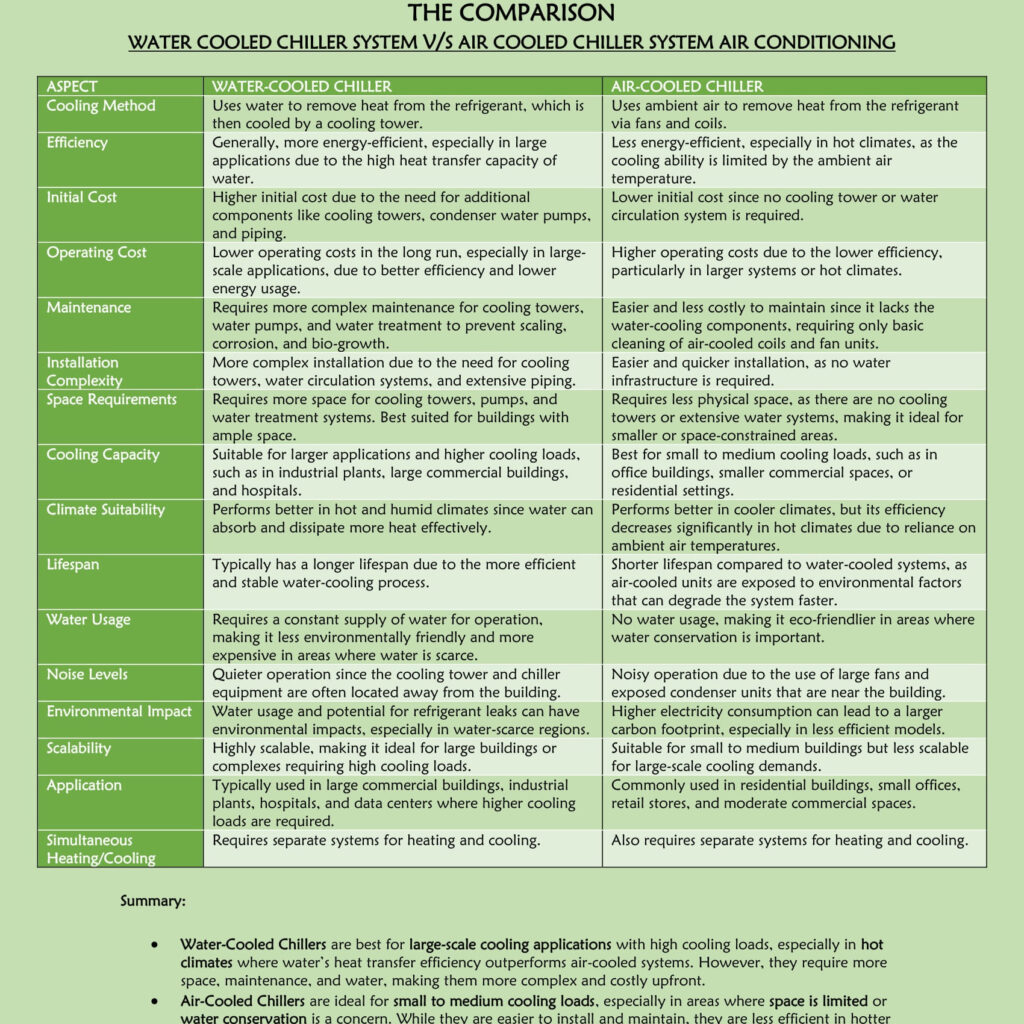
WATER COOLED CHILLER SYSTEM V/S AIR COOLED CHILLER SYSTEM AIR CONDITIONING:
| ASPECT | WATER-COOLED CHILLER | AIR-COOLED CHILLER |
| Cooling Method | Uses water to remove heat from the refrigerant, which is then cooled by a cooling tower. | Uses ambient air to remove heat from the refrigerant via fans and coils. |
| Efficiency | Generally, more energy-efficient, especially in large applications due to the high heat transfer capacity of water. | Less energy-efficient, especially in hot climates, as the cooling ability is limited by the ambient air temperature. |
| Initial Cost | Higher initial cost due to the need for additional components like cooling towers, condenser water pumps, and piping. | Lower initial cost since no cooling tower or water circulation system is required. |
| Operating Cost | Lower operating costs in the long run, especially in large-scale applications, due to better efficiency and lower energy usage. | Higher operating costs due to the lower efficiency, particularly in larger systems or hot climates. |
| Maintenance | Requires more complex maintenance for cooling towers, water pumps, and water treatment to prevent scaling, corrosion, and bio-growth. | Easier and less costly to maintain since it lacks the water-cooling components, requiring only basic cleaning of air-cooled coils and fan units. |
| Installation Complexity | More complex installation due to the need for cooling towers, water circulation systems, and extensive piping. | Easier and quicker installation, as no water infrastructure is required. |
| Space Requirements | Requires more space for cooling towers, pumps, and water treatment systems. Best suited for buildings with ample space. | Requires less physical space, as there are no cooling towers or extensive water systems, making it ideal for smaller or space-constrained areas. |
| Cooling Capacity | Suitable for larger applications and higher cooling loads, such as in industrial plants, large commercial buildings, and hospitals. | Best for small to medium cooling loads, such as in office buildings, smaller commercial spaces, or residential settings. |
| Climate Suitability | Performs better in hot and humid climates since water can absorb and dissipate more heat effectively. | Performs better in cooler climates, but its efficiency decreases significantly in hot climates due to reliance on ambient air temperatures. |
| Lifespan | Typically has a longer lifespan due to the more efficient and stable water-cooling process. | Shorter lifespan compared to water-cooled systems, as air-cooled units are exposed to environmental factors that can degrade the system faster. |
| Water Usage | Requires a constant supply of water for operation, making it less environmentally friendly and more expensive in areas where water is scarce. | No water usage, making it eco-friendlier in areas where water conservation is important. |
| Noise Levels | Quieter operation since the cooling tower and chiller equipment are often located away from the building. | Noisy operation due to the use of large fans and exposed condenser units that are near the building. |
| Environmental Impact | Water usage and potential for refrigerant leaks can have environmental impacts, especially in water-scarce regions. | Higher electricity consumption can lead to a larger carbon footprint, especially in less efficient models. |
| Scalability | Highly scalable, making it ideal for large buildings or complexes requiring high cooling loads. | Suitable for small to medium buildings but less scalable for large-scale cooling demands. |
| Application | Typically used in large commercial buildings, industrial plants, hospitals, and data centers where higher cooling loads are required. | Commonly used in residential buildings, small offices, retail stores, and moderate commercial spaces. |
| Simultaneous Heating/Cooling | Requires separate systems for heating and cooling. | Also requires separate systems for heating and cooling. |
Summary:
- Water-Cooled Chillers are best for large-scale cooling applications with high cooling loads, especially in hot climates where water’s heat transfer efficiency outperforms air-cooled systems. However, they require more space, maintenance, and water, making them more complex and costly upfront.
- Air-Cooled Chillers are ideal for small to medium cooling loads, especially in areas where space is limited or water conservation is a concern. While they are easier to install and maintain, they are less efficient in hotter climates and have higher operating costs.
